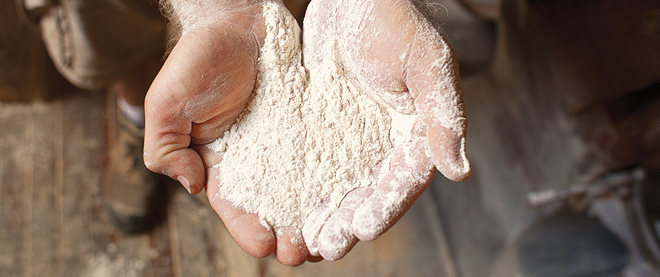A baking test with stone-milled flour
Having a bag of culinary history was great, but what would it taste like as bread?
Share

Some weeks back, a friend of mine returned from a lamb-eating expedition to Charlevoix, on the north shore of the St. Lawrence, with the thoughtful and intriguing gift of a bag of flour from an old Quebec mill. A very old Quebec mill called Laterrière at Les Éboulements, which was built around 1790 and functions today precisely as it did then, via the combined forces of water power, grindstones, and a miller named Tremblay (Jean-Guy, the current meunier, is a descendant of the original owner, Jean-François).
What’s more, the flour in the bag is made exclusively from wheat grown on those same nearby fields that were once part of the seigneury that the mill was built to service.
Pretty nifty, it seemed to me. A nice one-kilo bag of culinary history to keep on my desk. But what I really wanted to know was what it tasted like, as bread.
Rather than bake, eat and forget, this seemed like a perfect opportunity to do some comparison testing. To make the same bread recipe with a few different flours, and find out how the old-fashioned stone-milled stuff stacked up against cutting-edge impact-milled supermarket flour and a handful of other samples.
For the supermarket flour, I settled on the Robin Hood brand (it was in the cupboard). For comparative artisan flour, I ordered up some samples from Ontario’s Arva Flour Mill, established in 1819, which now grinds its wheat into flour on contemporary steel rollers but still adheres to the old principle of a low-speed process (as speed and friction add flavour-altering heat to the process). And for good measure, I picked up some extra organic samples from the food-a-phobic health food store near me, too. Then it was time to get started.
Unfortunately, the bag from Laterrière is labelled simply “blé naturel”—which is to say, natural wheat. It does not indicate whether the flour contained therein is soft, hard, bleached or unbleached, white or whole wheat. But tearing it open revealed what looked like perfect bread flour, its grind coarse and textured rather than fluffy and white. So in an attempt to match it, I mixed the other samples in an ideal bread mix of hard, high-protein, unbleached white flour with whole wheat flour, in a ratio of 3:1.
Next, it was time to choose a basic recipe. The obvious answer was New York baker Jim Lahey’s (Sullivan Street Bakery) recipe for pane integrale. Because it seemed to me that his no-knead method of stirring up a wet dough with very little yeast and then leaving it to ferment for 12 to 18 hours would give the flours their best chance to develop their distinct flavours. Furthermore, removing kneading from the equation would handily eliminate that flavour-changing variable from the experiment. And likewise any differences in ambient temperature—for all four batches could be prepared simultaneously, making temperature a constant. Best yet, while the dough proofed, I could read a book and go to sleep.
The differences in the raw dough were apparent the next day. Even though the constituent flour, water, salt and yeast had been measured equally with precise digital scales for each batch, the Arva dough was much wetter than any other, and the Robin Hood mixture was by far the driest. The necessary equalization adjustments made, it was time to bake.
Loaves lined up at the end of the day, I gave the Arva bread the nod for having formed the best bronzed and most crackingly crisp crust. Robin Hood came second, with Laterrière and the basic organic mix tied close behind. Slicing the loaves open, Arva again led the pack with its enticing, mildly sour aroma, while the Robin Hood had floury notes, and Laterrière and the health food were lodged in the innocuous middle ground. But then, in the matter of taste, it was the Quebec flour that had produced far and away the most elastic, moist and pleasantly aerated crumb.
Which leaves me with no possible conclusion, other than I should give up baking and resume shopping at La Petite Thuet, the best bakery I know—and only a five-minute drive from home. Lucky me.